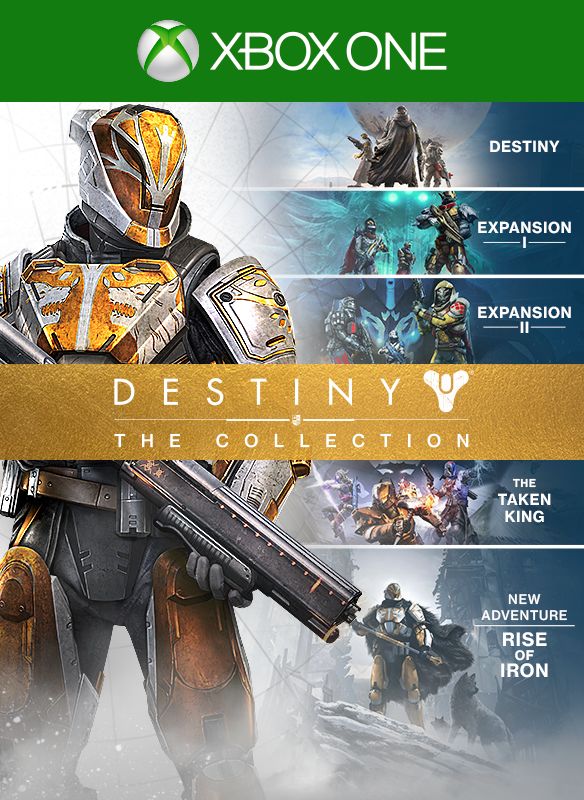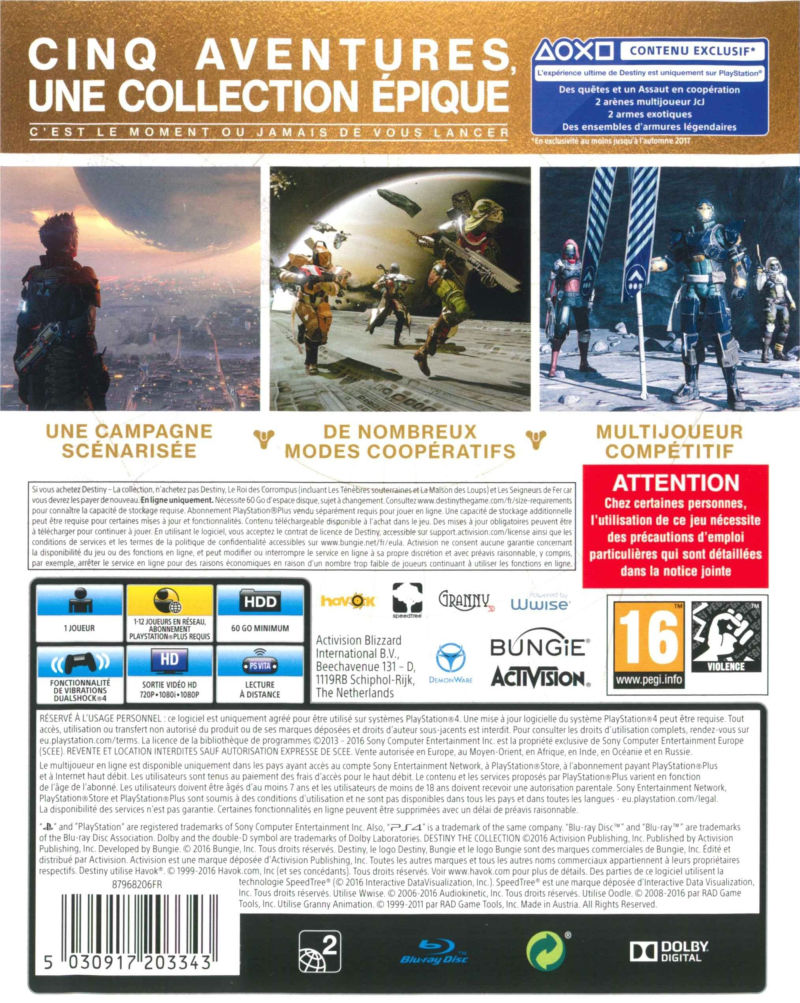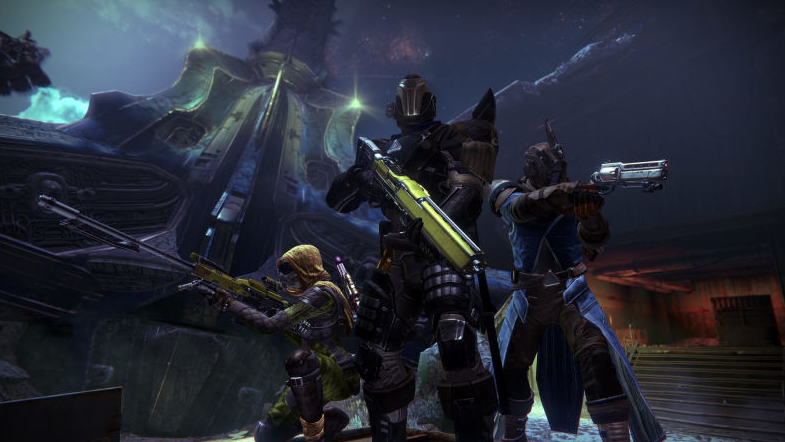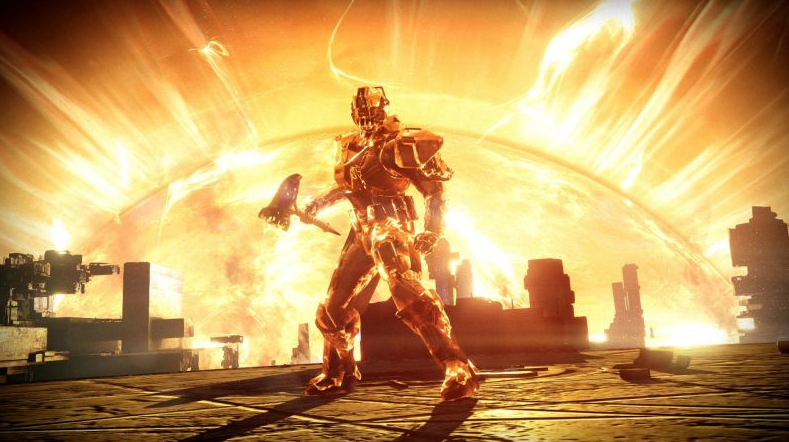Destiny: The Collection combines all content for the game Destiny in a single package. It includes:
- Destiny (base game)
- Destiny: Expansion I – The Dark Below (DLC)
- Destiny: Expansion II – House of Wolves (DLC)
- Destiny: The Taken King (DLC)
- Destiny: Rise of Iron (DLC)
- Iron Gjallarhorn and Iron Gjallarwing Sparrow (Rise of Iron pre-order bonus DLC)
- Character boost to level 40
While all content was previously also available for PS3 and Xbox 360, Destiny of Iron was only made for PS4 and Xbox One, so PS3 and Xbox 360 do not have this The Collection edition. The DLC Destiny of Iron was launched simultaneously with this edition. There are options to upgrade to this The Collection edition.
Destiny is a futuristic first-person shooter set in a persistent world. When humans first set foot on Mars they discovered the Traveler, a giant sphere that then allowed mankind to colonize space quickly. Centuries later the Darkness, an enemy of the Traveler, arrived and waged war against it and all of its creations. The Traveler is forced to scarify itself as a measure of protection and what is left of humanity on Earth is forced to live in a city constructed underneath. The Traveler enlists warriors known as Guardians with special abilities as a personal army. These Guardians are guided by Ghosts, artificial intelligence. The player’s character is found by such a Ghost (acting as a robot companion in the game) and becomes a Guardian.
At the start the player chooses a class (Titan, Hunter or Warlock – corresponding with the classic Fighter, Rogue and Mage) and then customizes the appearance through race (Human, Awoken or Exo), gender, face, hair and marking. Each class has distinct abilities. The Titan is a fighter with an advanced mech suit, the Hunter is a bounty hunter with a knack for reconnaissance and ranged weapons, and the Warlock is a magical being that uses spells and explosives. Each class has various subclasses (unlocked at level 15) and specific abilities and statistics. None of the weapons in the game are restricted to a single class. The most distinct differences are the grenade types, jump abilities, melee attack and a special ability. The game borrows elements from the MMORPG genre in its design, with the Tower as a main hub zone to interact with NPCs, buy weapons, gear and Ghost upgrades, receive mail, buy and upgrade ships etc. Rewards for completing missions can also usually be collected here. The other major zones are Earth, the Moon, Mars and Venus, with some additional locations. While fighting, movement and jumps are important when confronting enemies. A Guardian can wield up to three main weapons (primary, special and heavy) next to grenades and other abilities. Only one weapon of each type can be equipped, but nine more for each type can be stored in an inventory to swap them.
Ships are used to travel through space to other planets. These voyages are not an interactive scene however as the game does not have a complete open world design. Each planet has its own story and various quests. Players complete missions by defeating enemies, collecting loot. Glimmer, the main currency is used to buy upgrades, vehicles, emblems … The character also gains experience and levels up, accessing new abilities. From level 18 Vanguard Marks are unlocked as an additional currency for high-end gear, along with Vanguard Reputation as a reward for completing bounties. There are daily and weekly challenges to earn Marks, but the amount that can be earned has time constrictions. From level 20 the general experience system is replaced by Mote of Light. At that level the characters also gets to join one of three factions: Dead Orbit, New Monarchy or Future War Cult. The main story consists of different campaign missions that need to be completed for The Speaker, unlocked gradually and opened up on Earth, Moon, Venus and Mars respectively. Once unlocked however, they can be completed in any order. Next to the mission progression it is possible to enter a planet in exploration mode, offering free exploration. Each planet generally has five major story missions. These can be completed alone or in groups of six players working together.
Players can also optionally organize themselves in Fireteams for Strike missions, similar to MMORPG dungeons, that are harder with various mini-bosses and bosses. Fireteams are organized through online matchmaking and it is possible to make them public or private, and invite players. Only in Fireteams is voice chat possible. Outside of it communication is limited to gestures and prompts. Players also do not see all other online players at that location, only a selection. For the instance missions, the player’s character (and possibly other team members) are drawn in a private part in the game, cut off from the open game world. In these section characters can revive each other and there are checkpoints for respawns. Loot is personalized and does not need to be distributed between players. Each planet contains five major loot chests. Certain weapons and armour have a ranking system where they become better over time. There are also various types of engrams, a type of pattern for weapons or amour that can be turned into a special item with colour coding for the rarity level. Decoding them improves a separate ranking system with leveling to access additional engrams. When dead, other players can attempt to revive the player’s character with its Ghost nearby or eventually it respawns. Moving around on planets can be done on speeder bikes.
There are also Raids, much harder cooperative missions added gradually by the developer that do not support matchmaking and can only be taken on with players at a high level with high-end gear. Unlike Strike missions, no objectives or directions are given, players have to figure it out for themselves. Raids can be paused and resumed, unlike most of the rest of the game, but are reset after a weekly cycle. Competitive multiplayer is available in the The Crucible PvP game mode in a separate location. It offers game modes unlocked gradually including Clash, Control, Skirmish and Rumble. They come with different team sizes and include team deathmatch, capturing zones, team modes with vehicles and more. Level differences between players are nullified except for the skill tree unlocks, but the strength of the gear, weapons and equipped items makes a significant difference. The Crucible offers Crucible Marks as a currency along with Crucible Reputation.
Cover Art:
Screenshots:





